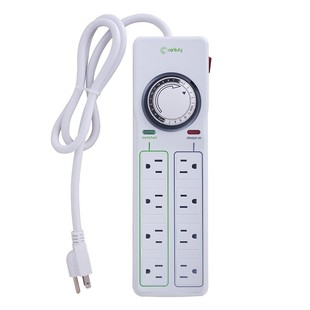 Goal
Save on energy costs by activating more conservative power settings on workplace devices.
Cost to ImplementUsually free if you already have built-in power management controls.
Ease of ImplementationEasy for offices with centralized IT management, but more difficult for offices with a lot of personal devices and decentralized management.
Goal
Save on energy costs by activating more conservative power settings on workplace devices.
Cost to ImplementUsually free if you already have built-in power management controls.
Ease of ImplementationEasy for offices with centralized IT management, but more difficult for offices with a lot of personal devices and decentralized management.
About how many desktops do you have at your organization?
Estimated Savings: If you were to optimize all of your desktop's power settings, you could save an estimated $0 anually ($25 per desktop). Source: EPA's Power Management for Computers and Monitors
What best describes your office's IT management practices?
Steps to Implement: Depends on your office's management practices. Please answer the question above.
 Goal
Save on energy costs by purchasing green certified electronics.
Cost to ImplementPotential increase in purchasing costs upfront, but certifications such as Energy Star guarantee that the energy saving's from their certified products will decrease long-term costs.
Ease of ImplementationEasy for those who have centralized and slightly flexible electronics purchasers, although it might take more time to find and purchase electronic devices at first.
Goal
Save on energy costs by purchasing green certified electronics.
Cost to ImplementPotential increase in purchasing costs upfront, but certifications such as Energy Star guarantee that the energy saving's from their certified products will decrease long-term costs.
Ease of ImplementationEasy for those who have centralized and slightly flexible electronics purchasers, although it might take more time to find and purchase electronic devices at first.
How many desktops does your organization own?
What percentage of your desktops are green certified (EPEAT, EnergyStar, etc.)?
%
How many laptops does your organization own?
What percentage of your laptops are green certified?
%
How many smartphones does your organization own?
What percentage of your smartphones are green certified?
%
Estimated Savings: If you were to purchase all EPEAT devices, you could save an estimated $0. Source: EPEAT's Savings Calculator
What best describes technology procurement at your organization?
Steps to Implement: Depends on your office's procurement practices. Please answer the question above.
 Goal
Increase collaboration, reduce travel costs with telecommuting, and save on printing by promoting the use of cloud-based file-sharing services in your office.
Cost to ImplementUsually about $5 - $15 per employee per month (depending on your subscription).
Ease of ImplementationEasy if most employees are comfortable with technology and willing to use it to collaborate with others.
Goal
Increase collaboration, reduce travel costs with telecommuting, and save on printing by promoting the use of cloud-based file-sharing services in your office.
Cost to ImplementUsually about $5 - $15 per employee per month (depending on your subscription).
Ease of ImplementationEasy if most employees are comfortable with technology and willing to use it to collaborate with others.
How many employees do you have?
About what percentage of your employees have access to and use a cloud-based file-sharing service such as Google Drive, Google, Suite, Microsoft Office, or DropBox?
%How much do you spend on paper each week?
How much do you spend on ink and toner each week?
Estimated Service Cost: If you were to purchase a subscription for a cloud-based file-sharing service for all of your employees, your costs would be about $0 per month. Source: Brame and Sevilla (PC Magazine 10/25/19)
Estimated Savings: If you were to eliminate all printing, your savings would be about $0 per month.
What best describes most of your employees?
Which best describes your organizations' workplace collaboration (e.g. meetings, shared projects, etc.)?
Steps to Implement: Depends on your office's collaboration and technology practices. Please answer all of the questions above. Source: Kerner (Datamation 10/25/19)
 Goal
Save on paper and ink by updating to more efficient printing defaults.
Cost to ImplementGenerally free. Most printers and offices will have the necessary systems built-in.
Ease of ImplementationEasy for offices with centralized IT management, but more difficult for offices with a lot of personalizes devices and decentralized management.
Goal
Save on paper and ink by updating to more efficient printing defaults.
Cost to ImplementGenerally free. Most printers and offices will have the necessary systems built-in.
Ease of ImplementationEasy for offices with centralized IT management, but more difficult for offices with a lot of personalizes devices and decentralized management.
How much does your organization spend on paper each month?
How much does your organization spend on ink and toner each month?
Estimated Savings: If you were to update your printer's defaults to double-sided printing, you could save up to $0 per month on paper and ink costs.
What best describes your office's printing practices?
Steps to Implement: Depends on your office's printing practices. Please answer the question above.
 Goal
Ensure the proper and safe disposal of all electronic waste from your institution in order to reduce your organization's electronic waste pollution and ensure that all of your company's data is deleted from all devices that are removed from the workplace.
Cost to ImplementLikely free. Many commerical electronic recyclers will either free services and some will even pay your organization for its old devices.
Ease of ImplementationDepends on your current practices and access to electronic recyclers. Relatively easy if you already have centralized disposal practices and a contract with an electronic recycler. More difficult and time consuming if you do not have at least one of those.
Goal
Ensure the proper and safe disposal of all electronic waste from your institution in order to reduce your organization's electronic waste pollution and ensure that all of your company's data is deleted from all devices that are removed from the workplace.
Cost to ImplementLikely free. Many commerical electronic recyclers will either free services and some will even pay your organization for its old devices.
Ease of ImplementationDepends on your current practices and access to electronic recyclers. Relatively easy if you already have centralized disposal practices and a contract with an electronic recycler. More difficult and time consuming if you do not have at least one of those.
Estimated Savings: Unfortunately, since every electronic recycler offers different services, it is difficult to estimate how much you could save by implementing centralized electronic recycling. For more details, find an electronic recycler that serves your area. Below are a list of questions to consider for when choosing an electronic recycler.
- Are they certified? The two main electronic recycling certifiers are R2 and e-Stewards.
- Do they guarentee device destruction or will they resell your whole devices?
- Will the company pick up your devices or do you need to drop them off somewhere? If it will pick them up, how often will they do so?
- Will the company pay you for your old devices?
- Will they take all of your electronic devices?
What best describes your current IT disposal practices?
Do you already use a specific electronic recycler?
Steps to Implement: Depends on your current disposal practices. Please answer all of the questions above.
 Goal
Save money on electricity by using smart power strips to reduce energy waste caused by Vampire IT.
Cost to ImplementDepends on the number and quality of smart power strips you purchase. As explained by Verde's 2018 article, most smart power strips cost about the same as regular power strips and will eventually pay for themselves. However, the return on investment will vary depending on the type and number of appliances that you plug into each power strip.
Ease of ImplementationPretty easy, but will take a few hours to purchase and plug in power strips to each workstation and, if applicable, kitchen space.
Goal
Save money on electricity by using smart power strips to reduce energy waste caused by Vampire IT.
Cost to ImplementDepends on the number and quality of smart power strips you purchase. As explained by Verde's 2018 article, most smart power strips cost about the same as regular power strips and will eventually pay for themselves. However, the return on investment will vary depending on the type and number of appliances that you plug into each power strip.
Ease of ImplementationPretty easy, but will take a few hours to purchase and plug in power strips to each workstation and, if applicable, kitchen space.
How many workstations are in your workplace?
How many of each of the following devices are in most of the workstations at your office? If any of the devices are in a specific fraction of the workstations, enter the appropriate decimal.
Desktop Computers Notebook Computers (Laptops) Mobile Phone Chargers Fax Machines Desktop Phones Printers
How many shared multifunction devices are in your workplace?
How many TVs are in your workplace?
How many kitchen spaces do you have around your workplace?
How many of each of the following devices are in most of the kitchen spaces at your office?
Microwave Oven
Coffee Maker
How much does your electricity cost per kWh?
Estimated Upfront Cost: If you were to purchase a $15 smart power strip for each workstation, shared device, and kitchen space, your costs would be $0.
Estimated Savings: If you were to use a smart power strip for the devices you checked above, your savings would be about $0 per year. Source: Save On Energy's Vampire IT CalculatorAll savings estimated based on the calculator's results. Please visit their website for more exact results and additional information.
Estimated Return on Investment: The energy savings from the smart power strips will cover the upfront cost after 0 months.
